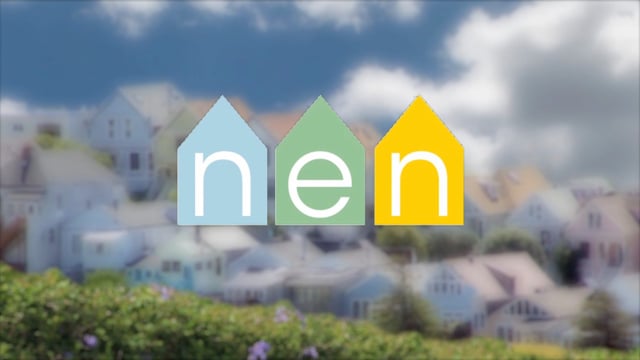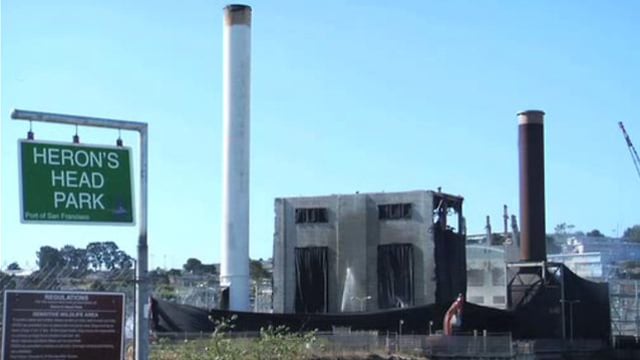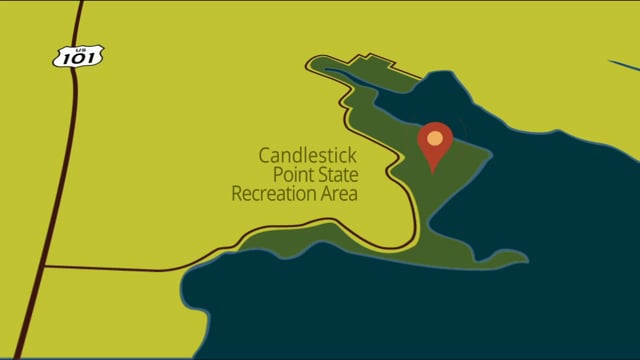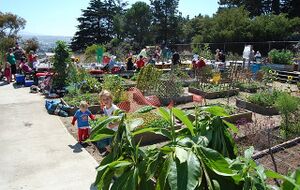
The aim of this page is to recognise, celebrate and encourage the self-empowerment of community agency networks (CANs) and community groups' activism for climate, environment and many other sustainability topics across San Francisco. San Francisco community resources is a separate page.
- What Happened After Market Street Went Car-Free, Mar 10, 2020...citylab.com
- Bank On San Francisco: Supporting community financial empowerment, May 1, 2019...Shareable
- Tiny neighborhood libraries worth checking out, Feb 9, 2019...sfchronicle.com
Networks and sustainability initiatives[edit | edit source]
- Empowersf, Neighborhood Empowerment Network
- Transition San Francisco (latest site activity Feb 6, 2013, accessed 07:45, 1 November 2014 (PDT)) Resources on the site include: Transition SF Roadmap and a list of Community Meeting Spaces in San Francisco
Regular events
- San Francisco Green Drinks, 1st Tuesday of Every Month
- Sunday Streets: Introduced in 2008, Sunday Streets aims to promote public health and community participation by closing a series of streets on automobile traffic on selected Sundays throughout the year. In 2014, there were nine events. The events allow residents to bicycle, skate, run, walk, do yoga, or just people-watch in public spaces normally devoted to automobiles.[1]
- April: Earth Day San Francisco
Ethical consumerism[edit | edit source]
- The Good Hotel, a San Francisco hotel in the SOMA district that prides itself on being environmentally friendly. Its motto is "Renew, Reuse, Recycle, Relax".
- SF Approved, Products that meet San Francisco's Health and Environmental Requirements, published by San Francisco Department of the Environment
Sustainable transport activism[edit | edit source]
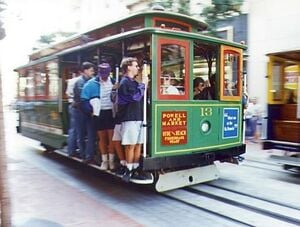
Transit.511.org, plan a trip
32% of San Francisco residents use public transportation for their daily commute to work, ranking it first on the West Coast and third overall in the United States. San Francisco was an early adopter of carsharing in America. The non-profit City CarShare opened in 2001. Zipcar closely followed. W
See also: San Francisco Sustainability, Air Quality and Transportation
Walking:
San Francisco Bay Trail - Walking San Francisco Bay (blog)
In 2015, Walk Score ranked San Francisco the second-most walkable city in the United States. W
The San Francisco Bay Trail is a bicycle and pedestrian trail that when finished will allow continuous travel around the shoreline of San Francisco Bay. As of 2020, 356 miles (573 km) of the trail have been completed. When finished, the trail will be over 500 miles (800 km) of paved and gravel paths, bike lanes, and sidewalks, linking 47 cities across nine counties and crossing seven toll bridges. It is a project of the Association of Bay Area Governments (ABAG) and the Metropolitan Transportation Commission (MTC), in collaboration with other agencies, private companies, non-profit organizations, and advocacy groups.
The trail is intended to provide recreation for hikers and bicyclists, viewpoints for wildlife, space for environmental education, and corridors for bicycle transportation as well as access to historic, natural and cultural sites, including over 130 parks. W
Trails in the San Francisco Bay Area (category) W
Cycling activism[edit | edit source]
Bay Area Bike Share - Bike Kitchen San Francisco - San Francisco Bicycle Coalition - SF Critical Mass on facebook
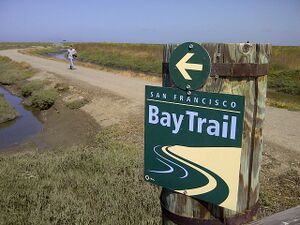
Cycling in San Francisco: Cycling is a popular mode of transportation in San Francisco, with 75,000 residents commuting by bicycle each day. Annual bicycle counts conducted by the Municipal Transportation Agency (MTA) in 2010 showed the number of cyclists at 33 locations had increased 58% from the 2006 baseline counts. In 2008, the MTA estimated that about 128,000 trips were made by bicycle each day in the city, or 6% of total trips. Since 2002, improvements in cycling infrastructure such as additional bike lanes and parking racks have made cycling in San Francisco safer and more convenient. Since 2006, San Francisco has received a Bicycle Friendly Community status of "Gold" from the League of American Bicyclists. W
Bay Wheels is a regional public bicycle sharing system in California's San Francisco Bay Area. It is operated by Motivate in a partnership with the Metropolitan Transportation Commission and the Bay Area Air Quality Management District. Bay Wheels is the first regional and large-scale bicycle sharing system deployed in California and on the West Coast of the United States. It was established as Bay Area Bike Share in August 2013. As of January 2018, the Bay Wheels system had over 2,600 bicycles in 262 stations across San Francisco, East Bay and San Jose.
In June 2017 the system was officially re-launched as Ford GoBike in a partnership with Ford Motor Company. After Motivate's acquisition by Lyft, the system was renamed to Bay Wheels in June 2019. The system is expected to expand to 7,000 bicycles around 540 stations in San Francisco, Oakland, Berkeley, Emeryville, and San Jose. W
Bike Kitchen San Francisco: bike co-op — a 501(c)(3) non-profit assisted-self-service bike shop located at 650H Florida Street in the Mission neighborhood. Its mission is to "teach people of all ages and backgrounds how to repair bicycles." Member pay a day-use fee, annual membership fee, or volunteer to gain access to the Bike Kitchen's tools, parts, and volunteer mechanics. W
San Francisco Bicycle Coalition: California 501(c)(4) nonprofit public benefit corporation established to "transform San Francisco's streets and neighborhoods into more livable and safe places by promoting the bicycle for everyday transportation." The SFBC in 2011 has a dues-paying membership of over 12,000, making it the largest bicycle advocacy organization in the United States. The SFBC organizes or promotes cycling-related events such as Bike to Work Day, Winterfest, Sunday Streets, and bike valet parking at public events. W
SF Critical Mass: The first Critical Mass bicycle ride took place on September 25, 1992 in San Francisco, and has since spread to hundreds of cities worldwide. The ride meets on the last Friday of each month at 6:00 pm at Justin Herman Plaza, and is typically attended by several thousand cyclists, who then ride through the city en masse, claiming the normally auto-dominated streets for bicycle use. The event is controversial even within the cycling community in San Francisco, some claiming that it raises beneficial public awareness of cycling issues, and others claiming that it reduces public support for cyclists' needs by enraging motorists and commuters blocked by the event. W
Bike to Wherever Days 2020, September 2020, bayareabiketowork.com
Bay Area Bike to Work Day is an annual Bike-to-Work Day event held in the San Francisco Bay Area encouraging and promoting bicycle commuting. The event is an initiative of the Metropolitan Transportation Commission, and supported by local partners including the San Francisco Bicycle Coalition, Bike East Bay, Silicon Valley Bicycle Coalition, Marin County Bicycle Coalition, Napa County Bicycle Coalition, and Sonoma County Bicycle Coalition. In 2018, nearly 100,000 people participated. W
See also: Cycling in San Francisco (category) W - Bike paths in San Francisco (category) W
Road safety[edit | edit source]
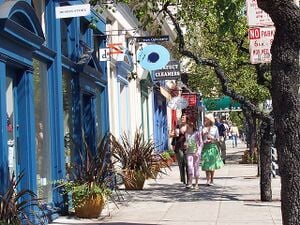
San Francisco has significantly higher rates of pedestrian and bicyclist traffic deaths than the United States on average. In 2013, 21 pedestrians were killed in vehicle collisions, the highest since 2001, which is 2.5 deaths per 100,000 population – 70% higher than the national average of 1.5. W
Education for sustainability[edit | edit source]
EcoCenter at Heron's Head Park
Designed to meet the needs of underserved Bayview-Hunters Point communities in southeast San Francisco, the EcoCenter at Heron's Head Park is a unique educational facility that combines environmental education, experience-based learning and habitat restoration. Located by the Bay in one of the last of San Francisco's wild landscapes, the EcoCenter is also a model for green building and sustainable resource use.
As a living classroom and drop-in visitor center, the EcoCenter demonstrates how environmental resources can be used to promote healthy people, vigorous ecosystems, and strong economies in local communities. To enhance community-building, the EcoCenter offers elementary school through college educational programming, internships for youth and young adults, tours, seminars, workshops, and other activities, all free of charge.
The EcoCenter's Science Saturdays program is a particularly popular series of weekly events appropriate for all ages. These hands-on activities range from park restoration and plastic debris cleanups, to climate change science experiments, to healthy cooking and eating demonstrations, and to citizen science field trips. Other ongoing activities include a unique opportunity for place-based green jobs training. Youth interns monitor onsite wastewater treatment, nurture a constructed wetland, participate in rainwater harvesting, and maintain renewable energy systems. Volunteers and guests are invited to join the staff for hands-on experiences with native plants, landscaping, and habitat restoration. By learning more about urban design that mimics natural processes, visitors better understand the connections between sustainability in the built environment and the local wetlands. They leave the EcoCenter inspired to pursue green resource use in their everyday lives. W
Environment quality[edit | edit source]
Adopt-A-Street Program, San Francisco Public Works
Open spaces[edit | edit source]
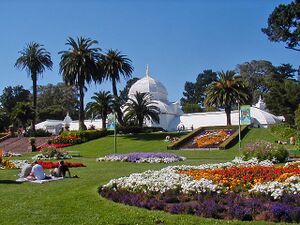
Several of San Francisco's parks and nearly all of its beaches form part of the regional Golden Gate National Recreation Area, one of the most visited units of the National Park system in the United States with over 13 million visitors a year.
There are more than 220 parks maintained by the San Francisco Recreation & Parks Department. The largest and best-known city park is Golden Gate Park, which stretches from the center of the city west to the Pacific Ocean. Once covered in native grasses and sand dunes, the park was conceived in the 1860s and was created by the extensive planting of thousands of non-native trees and plants. The large park is rich with cultural and natural attractions such as the Conservatory of Flowers, Japanese Tea Garden and San Francisco Botanical Garden. Lake Merced is a fresh-water lake surrounded by parkland and near the San Francisco Zoo, a city-owned park that houses more than 250 animal species, many of which are endangered. The only park managed by the California State Park system located principally in San Francisco, Candlestick Point was the state's first urban recreation area.
San Francisco is the first city in the U.S. to have a park within a 10-Minute Walk of every resident. It also ranks fifth in the U.S. for park access and quality in the 2018 ParkScore ranking of the top 100 park systems across the United States, according to the nonprofit Trust for Public Land. W
List of parks in San Francisco W
San Francisco Parks Alliance, 501c3 citywide nonprofit organization dedicated to parks and public space in San Francisco. "We've seen first hand the difference that community-focused public spaces can make, and we're passionate about bringing in all of the best resources together to support these projects across the city."[2]
Social inclusion[edit | edit source]
San Francisco Homeless Resource wiki
Glide, Glide's mission is to create a radically inclusive, just and loving community mobilized to alleviate suffering and break the cycles of poverty and marginalization.
Homelessness, historically, has been a major problem in the city and remains a growing problem in modern times.
In 2017, 7,500 homeless people were officially counted in the city, two-thirds of whom were dealing with serious health issues like mental illness or HIV. The city of San Francisco has been dramatically increasing expenditure directed to alleviate the homelessness crisis: spending jumped by $241 million in 2016–17 to total $275 million, compared to a budget of just $34 million the previous year. In 2017–18 the budget for combatting homelessness, much of which is directed towards the building of new shelters and expanding capacity, stood at $305 million.
In January 2018 a United Nations special rapporteur on homelessness, Leilani Farha, stated that she was "completely shocked" by San Francisco's homelessness crisis during a visit to the city. She compared the "deplorable conditions" of the homeless camps she witnessed on San Francisco's streets to those she had seen in Mumbai. W
San Francisco "declared itself a sanctuary city W in 1989, and city officials strengthened the stance in 2013 with its 'Due Process for All' ordinance. The law declared local authorities could not hold immigrants for immigration officials if they had no violent felonies on their records and did not currently face charges." The city issues a Resident ID Card regardless of the applicant's immigration status. W
About San Francisco[edit | edit source]
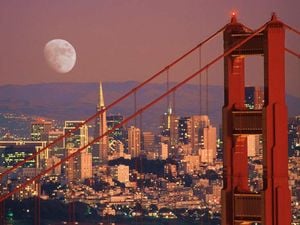
San Francisco is known as one of the greenest cities in the world and is known as a leader in the sustainable energies movement in the United States. The city of San Francisco is one of the most densely populated metropolitan areas in the country, yet still manages to reduce its waste and carbon emissions due to its implementation of energy efficient programs in recycling, public transport, and air quality. Through it's political output and community cooperation, the city has set a blueprint for the rest of the country to follow.[3]
San Francisco, officially the City and County of San Francisco, is a commercial, financial, and cultural center within Northern California. With a population of 808,988 residents as of 2023, San Francisco is the fourth-most populous city in the U.S. state of California behind Los Angeles, San Diego, and San Jose. It covers a land area of 46.9 square miles (121 square kilometers) at the upper end of the San Francisco Peninsula, making it the second-most densely populated major U.S. city behind New York City and the fifth-most densely populated U.S. county, behind four of New York City's boroughs. Among the 92 U.S. cities proper with over 250,000 residents, San Francisco is ranked first by per capita income and sixth by aggregate income as of 2022. San Francisco anchors the 13th most populous metropolitan statistical area in the United States, with almost 4.6 million residents in 2023. The larger San Jose–San Francisco–Oakland combined statistical area, the fifth-largest urban region in the U.S., had a 2023 estimated population of over 9 million.
San Francisco has had a very active environmental community. Starting with the founding of the Sierra Club in 1892 to the establishment of the non-profit Friends of the Urban Forest in 1981, San Francisco has been at the forefront of many global discussions regarding our natural environment. The 1980 San Francisco Recycling Program was one of the earliest curbside recycling programs. The city's GoSolarSF incentive promotes solar installations and the San Francisco Public Utilities Commission is rolling out the CleanPowerSF program to sell electricity from local renewable sources. SF Greasecycle is a program to recycle used cooking oil for conversion to biodiesel.
The newly completed Sunset Reservoir Solar Project has installed 25,000 solar panels on the 480,000 sq ft (45,000 m2) roof of the reservoir. The 5-megawatt plant more than tripled the city's 2-megawatt solar generation capacity when it opened in December 2010. W
Past events
- May 14, 2015, San Francisco's Bike to Work Day, (Wikipedia): San Francisco's Bike to Work Day, held in May of each year, aims to encourage commuters to try bicycling as a healthy alternative means of getting to work by organizing groups of cyclists to ride together starting from various neighborhoods, matching new bicycle commuters with more experienced "Bike Buddies", and providing free snacks and coffee at "Energizer Stations" along the busiest routes. Bike to Work Day raises awareness of cycling as a form of transportation, as bicycle have far outnumbered automobiles on the main commercial street, Market Street, during commuting hours on Bike to Work Day in recent years.
- May 28 - June 3, 2015, San Francisco Green Film Festival (Wikipedia): According to the festival's official website, the San Francisco Green Film Festival's mission is "to educate and connect communities through forward-thinking programs of environmental films and discussions."
External links
- City and County of San Francisco (Government Organisation) on facebook
References
